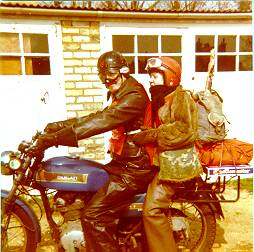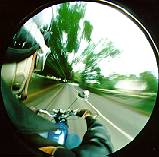Ducati Mark 3 250
 When I was at
university, Ducatis evoked a certain awe. They do today, and they
did then. In 1971 I had a friend who had a friend who had a
Ducati 350 with clip-ons and a megaphone, and he rode it around
the hills behind Perth (in West Australia). If it looked anything
like the yellow 250 Mark 3 Desmo in the picture(right) then he
was a lucky man.
When I was at
university, Ducatis evoked a certain awe. They do today, and they
did then. In 1971 I had a friend who had a friend who had a
Ducati 350 with clip-ons and a megaphone, and he rode it around
the hills behind Perth (in West Australia). If it looked anything
like the yellow 250 Mark 3 Desmo in the picture(right) then he
was a lucky man.
I never met this friend of a friend with his mythical bike,
but he always evoked in my mind the image of a motorcycling
equivalent of the Vitruvian man - an impossibly perfect harmony
of impeccable handling, an ear-shattering roar, and a big grin. I
saw a Ducati single at a race meeting (they were a popular race
bike) and it stood out from all the howling two-strokes with the
basso-profundo thunder of its exhaust. For no logical reason I
wanted one.
I found one in a bike shop in Cambridge in 1974. If I hadn't
been overcome with lust I would have shopped around rationally
and gone for the model in the picture above. I have never been
rational as far as bikes are concerned. The only difference was
the colour (mine was/is a metal-flake electric blue with gold
detailing), minor cosmetics (like no clip-ons), and an 8000 rpm
red line instead of the 8,500 red line on the Desmo. The valve
spring engine is often preferred because the Desmo is a nightmare
to work on.
 |
Myself and Ducati
c.1975. The front of the horrible little Yamaha 125 twin
is visible in the background. It has 'L' plates because I
was trying to persuade Jan that riding is even more fun
than sitting on a pillion. The strange object above the
rev counter is my leg resting on the kickstart. A
kickstart was an intermediate step in motorcycle design
which came between energetic pushing and electric
starters. In the case of the Ducati, the slightest
problem with ignition timing would break your leg (the
spark goes off, the piston hasn't enough inertia to pass
TDC, the crank rotates in the wrong direction, the
kickstart rachet is going the wrong way, and your leg
can't move upwards fast enough. A well-reported
occupational hazard.)
|
Apart from the handling, the Ducati's reputation comes from
the engine. In the 50's and 60's when mediocre build quality and
poor production line tolerances were routine in British bikes,
each moving shaft in a Ducati engine is individually shimmed to
an exact fit. This makes assembly and disassembly something of a
Chinese puzzle for the ham-fisted - the shims have to go back in
exactly as they came out - but it produces a tight engine. The
overhead cam is bevel-gear driven. The weight is 128 kgs. In the
early '60s Ducati issued a simple tuning kit which could be
fitted to the standard bike which lifted its top speed to over
100 mph - a Ducati 250 was independently tested at 104.1 mph.
These little bikes could out-handle and out-perform most large
capacity bikes on the market at that time. Mick Walker records
turning up at the 1970 Thruxton 500 on his standard road-going
Mark 3 250 and coming seventh against factory-prepared 1/4-litre
Japanese machines. The later Ducati V-twins were two 450 cc
single engines bolted onto a single crankcase.
I rode the Ducati a lot. In 1976 I moved from Cambridge to
London but I continued to ride back on a Friday night and spend
most weekends with Jan in Cambridge. We went up to Yorkshire many
times, and I went up to Newcastle a couple of times.
 |
This picture showcases
early '70s motorcycle clothing. Note the naff PVC jacket
(courtesy of a jumble sale), the clashing orange bib, the
open-face helmet painted gloss black and banged against a
rock a few times, the elegant fur jacket (courtesy of a
jumble sale), and the coordinated plastic overtrousers. Picture
c. 1977.
|
When I was in London looking at house numbers, trying to find
an advertised bedsit, I made the classic mistake of riding into a
stationary car and gave my wedding tackle an extraordinary wallop
on the petrol tank. I didn't drop the bike. I can recall a
passer-by inquiring whether I was "all right". I have
no idea how long I stood there with a fixed and inexplicable
expression on my face. When the bruising appeared a few days
later, and I could walk down the street without the same
inexplicable expression, I went to the doctor. He was
unimpressed.
The end came in the summer of 1977. Jan and I went drinking at
the Water Rat pub near World's End on the Kings Road. It was a
biker's pub, and it was the night of the Chelsea cruise, so the
place was packed. I drank three pints of best, pulled out quickly
across the road to avoid a cruiser coming around the corner,
locked the front wheel, and dropped the bike in front of the
assembled multitude. Moral: never drink so little beer that you
can still start your bike. The accident wrecked the speedo, the
front mudguard, the headlight, and didn't do Jan's foot a lot of
good.
I never rode the bike much after that, because I bought an XS 750 shortly afterwards. The cat pee'd all
over the wheels and I had them rebuilt by Alf Hagen in the
mid-80's. The seals went on the rear Marzocchi shocks and I
searched high and low for new seals. In the end I fitted Alf
Hagen replacements, which are firmer. I had some parts
re-chromed. The front mudguard is still warped following the
Kings Road incident. I suspect the front forks are ever so
slightly bent following the ball-bashing incident (the steering
feels lighter, and this may explained why it locked so easily). I
tried starting it recently and concluded the carb is gummed up
and will have to be stripped. I guess the front fork seals will
also need to be replaced.
I ought to sell the bike, but part of me wants to renovate it.
I don't know why. I have never been rational about bikes.
|
| Pictures taken by Jan while
travelling on the Ducati at 60 mph. |
Back to Home Page
Copyright © Colin Low
1997
 When I was at
university, Ducatis evoked a certain awe. They do today, and they
did then. In 1971 I had a friend who had a friend who had a
Ducati 350 with clip-ons and a megaphone, and he rode it around
the hills behind Perth (in West Australia). If it looked anything
like the yellow 250 Mark 3 Desmo in the picture(right) then he
was a lucky man.
When I was at
university, Ducatis evoked a certain awe. They do today, and they
did then. In 1971 I had a friend who had a friend who had a
Ducati 350 with clip-ons and a megaphone, and he rode it around
the hills behind Perth (in West Australia). If it looked anything
like the yellow 250 Mark 3 Desmo in the picture(right) then he
was a lucky man. 


